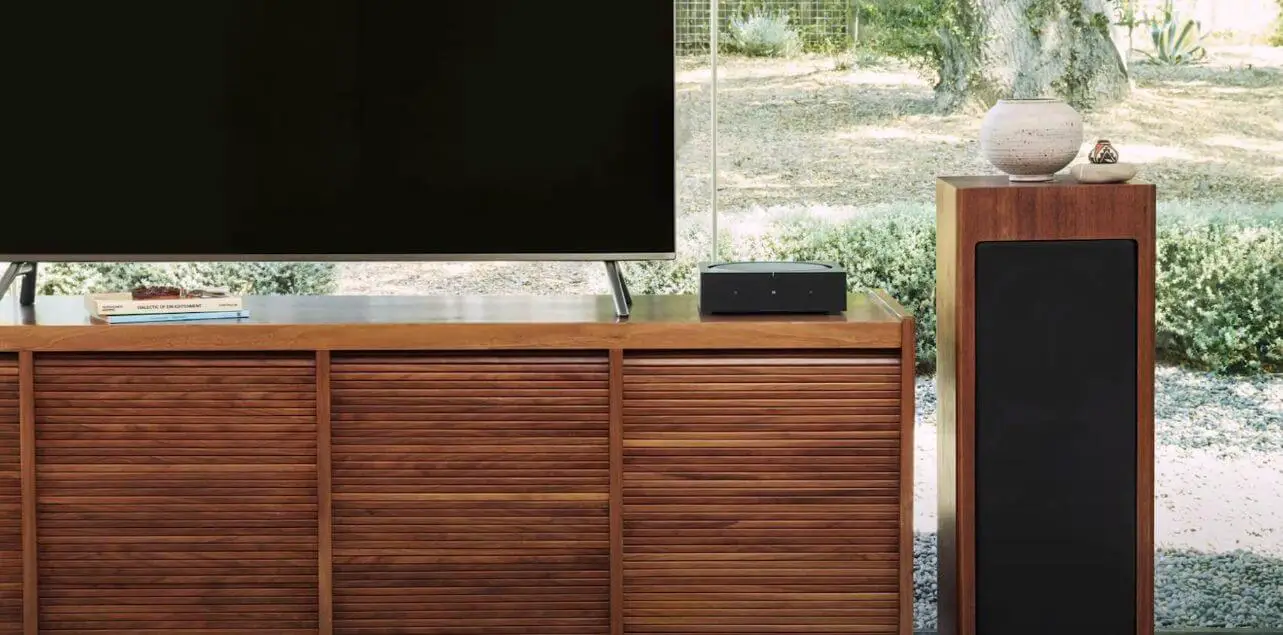Sonos Amp Review
We’re going to cover precisely what the Sonos Amp is, all of the applications that it can be used for, its internals and connections, and comparing it with some of its competitors so you can determine whether it’s going to be the right amp for you. So let’s get started.
First of all, what is the Sonos Amp? Well, it’s Sonos’s latest smart amplifier to power any passive third-party speakers that you have, with an impressive 125 watts of power per channel, whether that’s bookshelf speakers, floor standing speakers, in-ceiling, or outdoor speakers, for example.
In terms of connecting speakers to the Sonos Amp, you would use speaker cable, which is how they will power the speakers. It works like a traditional amplifier, but being a Sonos product, you’ll also gain access to the Sonos ecosystem. That is what makes it a smart amplifier. You can take advantage of wireless streaming from the wide choice of music streaming services available on the Sonos apps, such as Spotify, Amazon music, apple music, and lots more.
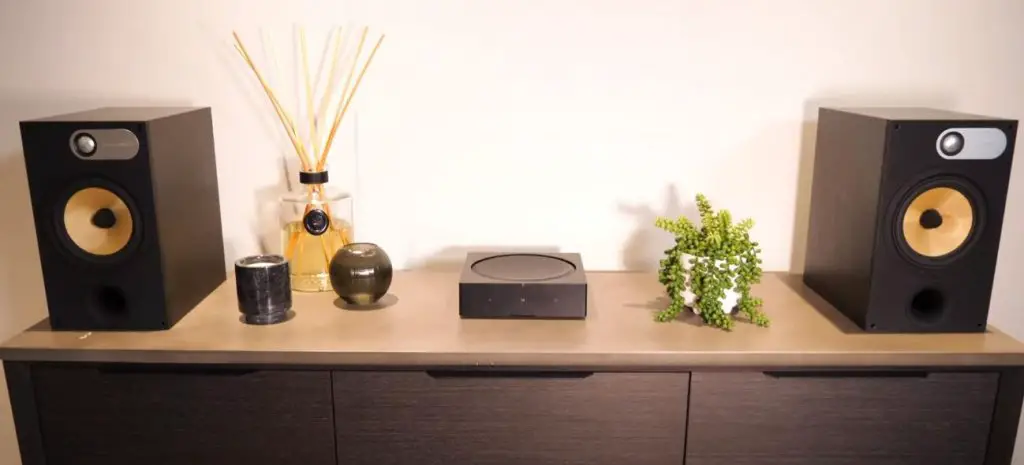
You’ve also got Airplay 2 on board. So you can stream any audio from your apple devices straight to the Amp and the speakers that it’s connected to. There are quite a few different scenarios that you can use the Sonos Amp in which we’ll cover a bit later on in this post.
Design
If we take a closer look at the product, you’ll notice it’s quite a lot smaller than traditional amplifiers. That is completely intentional from Sonos. Sonos wanted to get away from having amplifiers that take up large amounts of space. As it’s controlled wirelessly through the Sonos app, the only wires you need to get this up and running is the cable from the Amp to each of the speakers it’s powering and mains power for the Amp itself.
It’s also only sold in this black color, which is often referred to as stealth black.
On the front of the product, it’s quite minimalistic with a play pause button and volume controls, in case you’re near your Amp and you want quick control without needing to open the Sonos app. If we look at the back of the Amp, this is where all your connections are. The main power is the join button for connecting to wi-fi wirelessly, the speaker terminals where the speaker cable will run from, and then into each speaker terminals on the other speakers.
Sonos supply banana plugs in the box, and these ensure an effortless and neat connection from the speaker cable to the binding posts on the Sonos amp. You’ll notice a left and a right terminal, so you would wire your left speaker to the left channel and your right speaker to make a left and a proper stereo pair. You’ve also got a line in connecting other audio components such as a turntable or cd player.
There is an HDMI arc connection for your TV. So if you’d like to listen to the tv audio through the Amp and connected speakers, you would use this connection. You’ve also got a subwoofer out if you’d like to connect your active subwoofer to the Amp for more bass. Of course, you can pair Sonos’s sub wirelessly with the Amp, and you’ll then have the freedom to position that anywhere in the room. The Sonos Amp has two ethernet ports, one in and one out, so you can wire both to a router and a games console simultaneously for a reliable connection.
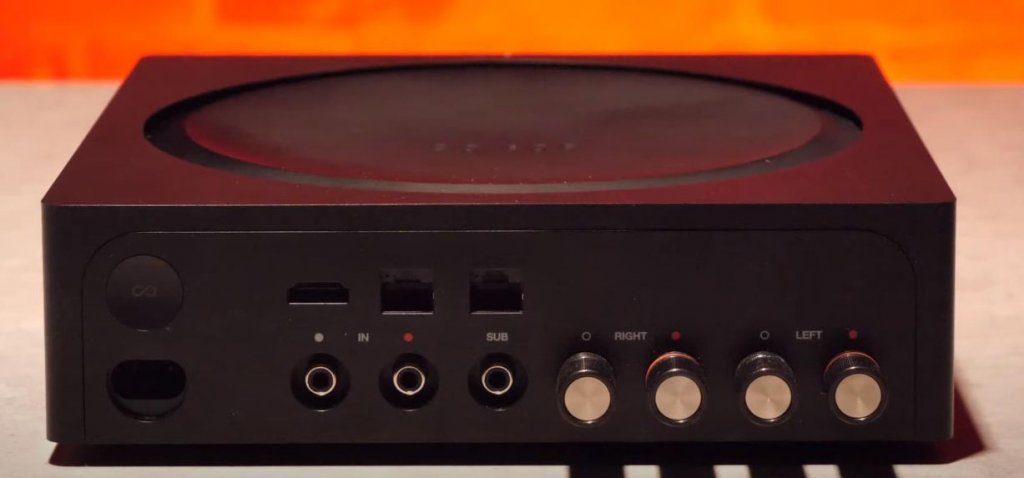
On the underside here, you’ll notice a ring design so that it can stack on other Sonos amps if you’re using multiple. And you can also fit two of these amps into a standard 19-inch rack if you have them professionally installed.
Application
Let’s move on to what you can use the Amp for then. One of the most popular solutions is to use it in conjunction with ceiling speakers. Most ceiling speakers are passive, which means they rely on a separate amplifier to run. Using the Sonos Amp to power them, you can combine ceiling speakers’ aesthetics with the convenience of wireless streaming from Spotify.
We see this increasingly in home extension renovation projects and new builds where access to the ceiling is much more comfortable, and you can run the cable in behind the ceiling for a neat finish.
You can install up to three pairs of Sonos’s ceiling speakers on one Amp, whereas you’re limited to two pairs if you use a different brand of ceiling speakers. That might be ample for your setup, though. So it does depend on the layout and size of your room as well as your listening needs.
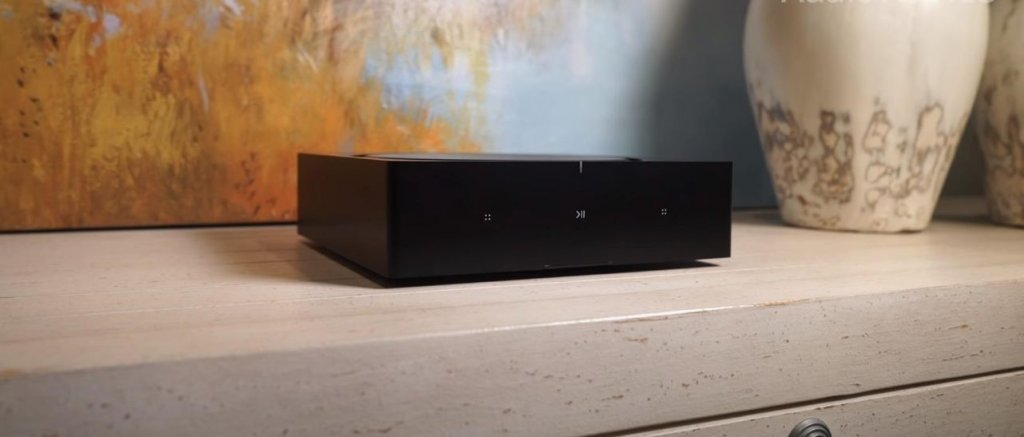
Another application that you can use the Sonos amp with is to power a set of the bookshelf or floor standing speakers to create a left and a right stereo pair, maybe for a hi-fi setup. You could use your existing bookshelf or floor standing speakers to replace the amplifier with the Sonos amp. Or you might prefer newer models such as the bowers and Wilkins 606 or 607s, which would be good as an upgrade or as a starter hi-fi setup. Of course, one of the significant benefits of having a separate amplifier and speakers is that you can upgrade the Amp or the speakers in the future should you wish to.
You can also use the Sonos amp to power a set of passive outdoor speakers for your garden or patio area. Again there are many options available such as wall-mounted or even rock speakers. This setup is an excellent idea if you’re looking for a permanent solution outdoors rather than using a portable outdoor speaker. When you go for a dedicated setup such as this, you’ll unlock a much better listening experience. However, if you don’t want to invest quite this much in your outdoor zone, I consider something like the Sonos Move portable speaker, which can be moved from room to room or outdoors if you want to stay in the Sonos ecosystem. Although, of course, there are lots of portable options out there.
The final setup that the Sonos amp is excellent for is with your TV. You can either connect the Amp directly to the tv via the HDMI arc input if you want the ability to listen to tv audio through the speakers that the Amp is connected to for a 2.0 stereo setup. That could be a set of a bookshelf, floor-standing, in-ceiling, or in-wall speakers.
Feature
One of the great features of the Sonos Amp is that it has a phantom center channel. That means that it will use parts of the left and the right channels to emulate a center channel. So the sound doesn’t feel like it’s coming too much from the left or too much from the right.
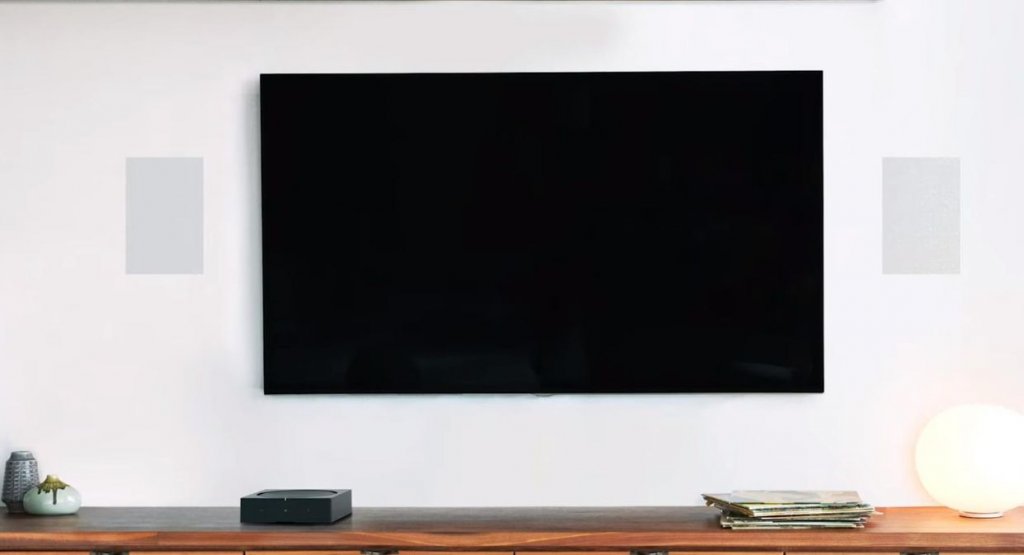
The Amp will also let you set it up as surround speakers, so we’ve seen many customers use the Sonos beam or the arc at the front with ceiling speakers powered by the Amp as rear surrounds. Suppose you didn’t want a soundbar at the front, maybe because you don’t like their aesthetics, and you still want it to benefit from a surround sound setup. You could have a pair of in-ceiling or in-wall speakers on either side of your tv at the front and the second set of in-ceiling or in-wall speakers as the rears.
You would need two amps in this configuration as the Amp can only do one thing at a time, either front left and right or a surround. This would give you a 4.0 Dolby digital setup, which can be finished off with a sub to create a 4.1 setup.
The other feature that makes the Amp great in tv setups is its IR sensor, so you can pair your existing tv remote with it as long as the Amp is in view of the remote. That means you don’t need to take out your phone every time to control the volume in the Sonos app.
Sonos Amp vs. Sonos Port
One of the most frequently asked questions is how the Amp is different from the Sonos Port? The Port falls into the category of being a wireless streamer, so it does everything that the Sonos amp does, but it doesn’t have the amplification built. So it can’t power existing speakers. The purpose of the Port is to be plugged into an existing amplifier, so maybe if you want to keep your current amplifier and speakers but want to give it an upgrade in the form of the Sonos ecosystem. The Port will do this for you.
Line in AutoPlay
Coming back to the Sonos Amp, I also want to talk in a little bit more detail about this line on the back. It’s an RCA input that is ideal for connecting something like a turntable, cd player, or any other audio component. What’s unique about this line is that once you’ve connected your chosen audio component to it, not only can you listen through the connected speakers, but you can group this audio to any other Sonos speakers that you have around your home using the Sonos app. That means you could theoretically be listening to your vinyl audio on all of the Sonos speakers in your home at the same time.
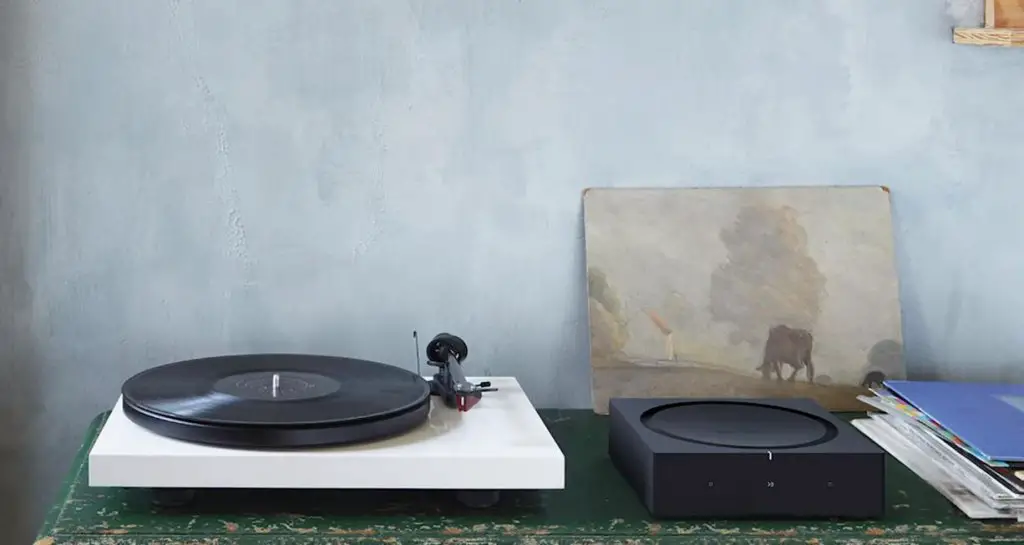
You can also automate the process and enable autoplay, so Sonos will automatically switch to the line in audio when it detects a source, such as when the needle hits the vinyl or when the cd starts spinning. So there are no further buttons to press.
Another great feature of the Sonos amp worth mentioning is the dual-mono mode. Traditionally the Sonos amp is supposed to power a left and a right speaker, so they become a true stereo pair. However, there are times where you may not necessarily want your speakers to be either a left or a right, and you may want them to play both of the channels through each speaker. The times that this will be useful is perhaps if you’re using ceiling speakers and you’re positioning the speakers around a corner or if they’re going to be placed more than five meters away from each other, where stereo separation effect might be lost. The dual-mono mode will ensure that you’re getting a balanced sound on each speaker, and it’s also a great get out of jail free card if you’ve only wired a single cable for a single stereo ceiling speaker.
For the most part, dual-mono mode won’t need to be used, but it is excellent for peace of mind and opens up your positioning options a bit more.
The strengths of the Sonos Amp
It offers a neater, more compact solution than traditional amplifiers while also adding wi-fi capabilities so you can unlock streaming and a comprehensive multi-room ecosystem for your existing speakers. It’s also very versatile and can be used in various setups, such as for a full home of ceiling speakers, in a tv setup, or for a stereo pair of bookshelf speakers. It also forms part of a whole-home sound system when used in conjunction with other Sonos speakers. I’m also thrilled with the amount of power this pushes out and 125 watts per channel. It’s not an audiophile standard, but this should be more than enough for the general day-to-day listener.
The weaknesses of the Sonos Amp
It doesn’t support Bluetooth, which may be a deal-breaker for some. It gets quite costly if there is a need to use multiple amps in your home. And it does also have only one line in. But of course, if you have various amps in your setup, this will eliminate this potential issue.
Their app is reliable and intuitive to use day-to-day, and their experience shows when you compare it with other similar wi-fi based systems. It will also get better over time, unlocking software upgrades when available, which are sometimes extremely useful.
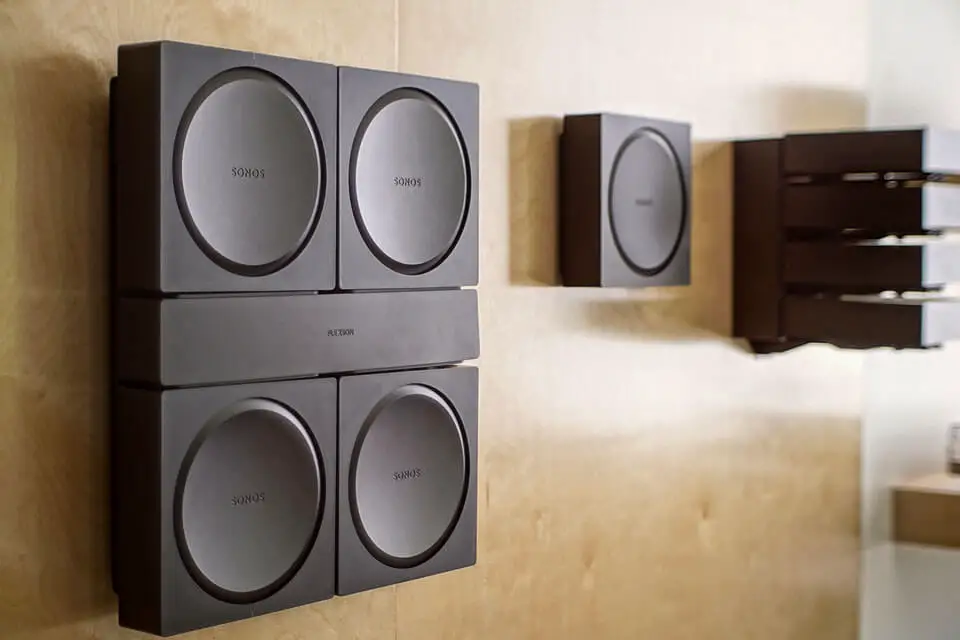
Conclusion
I think Sonos Amp shows us what a modern power amplifier should look like. Wireless and intelligent is a trend. Although power amp is often associated with “DIY” and “fever” in product definitions, this category will be impacted in the future. Therefore, actively embrace change is a bold but forward-looking choice.
Besides, Sonos Amp has found the right balance between household and industrial applications. On the one hand, its configuration and use are straightforward. Even if you haven’t touched any power amplifier products before, I believe you can start using it smoothly.
Sonos Amp is very suitable for these two types of consumers. One is for existing Sonos users. Amp can be physically connected to traditional speakers, further expanding the boundaries of the Sonos system at home. The other is to build a home theatre but did not start to act for some reasons. Amp can provide a worry-free solution.
